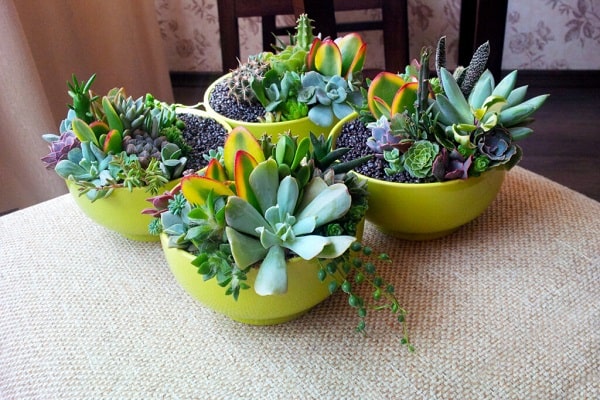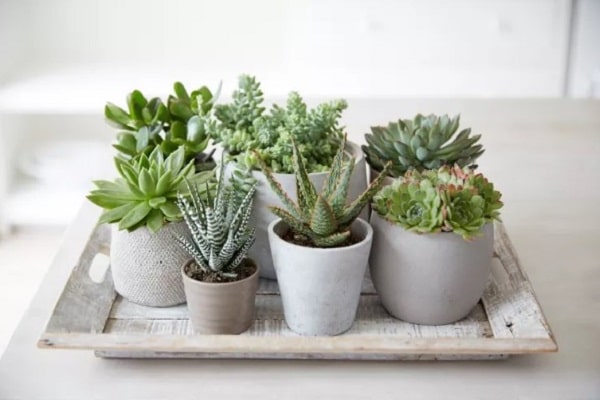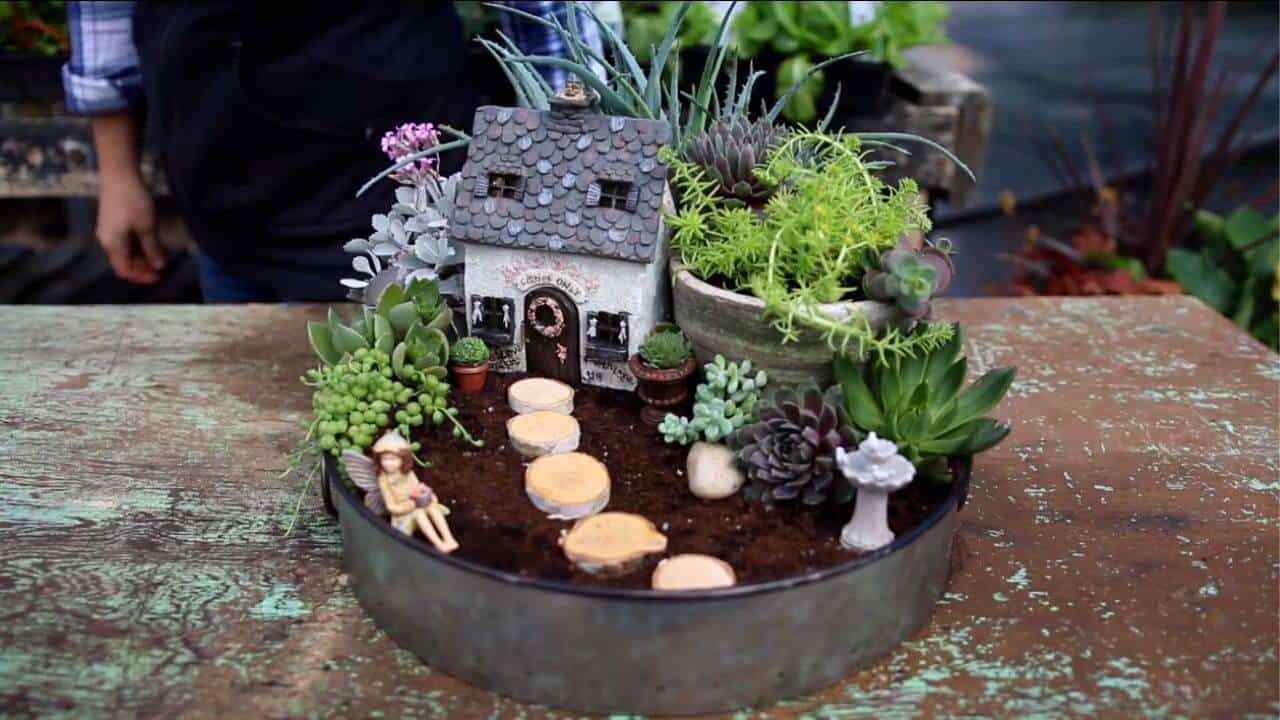A garden with sculptures or figurines of fairies, elves, or other fantastical creatures is known as a fairy garden. Succulents for fairy garden, residences, in a park. They are also well-liked tourist spots and frequently used as locations to unwind and appreciate nature.
Succulents are a popular choice for fairy gardens because they are low-maintenance and add a touch of whimsy. But with so many different types of succulents, it isn’t easy to know which ones to use in your fairy garden. I will help you choose the best succulents for the fairy garden in this article. I will also list some of my favorite succulents for fairy gardens.
Quick Navigation
How To Choose The Best Succulents For Fairy Gardens?

Succulents are popular plants for fairy gardens because they are easy to care for, look beautiful in a garden setting, and survive various conditions. When selecting succulents for a fairy garden, there are a few key things to consider:
Size
Some succulents are small enough to fit on a tabletop or in a pot, while others grow large enough to fill an entire container.
Shape and Form
Some succulents have broad leaves that look like miniature trees, while others have smaller, more delicate leaves.
Color
Succulents come in many different colors, including light green, dark green, yellow, red, orange, and even shades of purple.
Fragrance
Many succulents have strong fragrances that can add character to the garden.
Soil Preference
Since succulents are indigenous to warm regions, selecting one that will flourish in your garden’s environment is critical.
How Do You Make A Fairy Garden With Succulents?

Anyone who has visited a botanical garden or greenhouse knows succulents are ideal plants for fairy gardens. They are easy to care for, require little water and do well in various climates. Here is how to make a succulent fairy garden:
- Choose succulents that will fit in your desired environment. Succulents grown in the desert can handle hot, dry weather, while those grown indoors will do well in cooler temperatures.
- Prepare the soil by mixing gravel and compost until it is thick enough to hold moisture but not too heavy. Water the soil generously before planting your succulents.
- Plant the succulents in groups of three or four and space them about two inches apart. Water them regularly and fertilize as needed with a balanced organic fertilizer diluted 1/4 strength.
- Enjoy your succulent fairy garden!
10 Best Succulents For Fairy Gardens
Succulents are great for fairy gardens because they can tolerate various conditions. They are also low-maintenance plants, requiring little care other than watering regularly. Here are 10 of the best succulents for fairy gardens:
Echeveria
Succulents belonging to the large family Echeveria include the Ghost Echeveria, Painted Lady Echeveria, and Blue Rose Echeveria, among others. As they expand, this evergreen plant family grows in beautiful rosettes of succulent leaves that resemble lettuce or plum-petaled roses. The Echeveria family contains many magnificently eye-catching colored varieties that will make your miniature garden a spectacular sight. If you’re interested, here is an echeveria we discussed in great detail!
Aloe
One of the most popular succulents for fairy gardens is the Aloe, which comes in many colors and varieties, including lemons, oranges, greens, whites, and purples. Succulent aloes are easy to grow and care for – water them regularly and fertilize them when needed with a balanced organic fertilizer diluted 1/4 strength. Be sure to let them dry out between waterings to avoid root rot.
Crassula
This succulent is perfect for a fairy garden because its glossy leaves look like delicate fabrics. The Crassula family includes a wide range of colorful varieties that can grow in various climates, from mild to cold. Some popular Crassula species include the Jade Finchstone Crassula, Knight’s Slipper Crassula, and Mammillaria Maidenhair Crassula.
Sempervivum
Sempervivum is a succulent known for its rosettes of densely packed, needle-pointed leaves. This perennial is typically an indoor plant but can handle partial sun exposure and some rain. Sempervivum typically grows to about two feet, but a few varieties reach up to four feet.
Sedum
Sedums are one of the most common types of succulents in fairy gardens because they thrive in almost any climate and soil type – making them a great choice for novice succulent gardeners or those on a tight budget. Popular sedums include the Stonecrop Sedum ( Sedum earthii ), Hollyhock Sedum ( Sedum spurium ), Sweet Afton Sedum ( Sedum sweetie ), Fringed Maiden Hair Fern ( Athyrium filix-Femina ), Dumb Cushion Flower ( Dicentra Formosa ), Bee Balm ( Monarda didyma ), Foamy Venus Flytraps ( Dionaea muscipula ).
Echeveria Golden Star
Suppose you’re looking for an echeveria with striking Gold leaves that will add elegance and luster to your miniature garden. In that case, you’ll love Echeveria ‘Golden Star’. This cultivar grows tall – up to three feet – with delicately textured golden leaves that are dense and shiny on top but widely spaced on the otherwise soft stem below.
Mammillaria
The Mammillaria cactus is a popular choice for succulent gardeners because of its small size, slow-growing nature, and long life span. These plants are perfect for fairy gardens because they take a while to bloom (typically several months). Still, they produce an impressive bright crown of flowers. Some of the most popular Mammillaria cacti include the Aloe vera ( Aloe barbadensis ), Christmas Cactus ( Hymenocallis murals ), and the Blue Moon Cactus ( Mammillaria elongate ).
Echeveria Plumosa
If you’re looking for an echeveria with finely-textured, iridescent leaves, try Echeveria ‘Plumosa’. This cultivar grows to a height of three feet and has oval leaves that are deep green on the top and light green on the underside. The tips of the leaves are densely packed with small, white scales that give this EEcheveria its name – plumosa means “covered with plums.”
Crinum
Crinum is a species of succulents that is native to the Mediterranean region. These plants are easy to grow and produce attractive, long-lasting flowers in shades of pink, purple, or white. Crinum is popular for its unusual crinkled leaves (hence the name), and they are also known for its striking star-shaped flowers.
Skeleton Flower
If you’re looking for an unusual succulent to add to your fairy garden, try the Skeleton Flower ( Epiphyllum ). This succulent has long, spindly stems with few leaves and small, dull flowers. The branches are covered with short, white hairs that give the plant its name – skeleton flower.
Maintenance Tips For Succulents In A Fairy Garden

Succulents are a beautiful addition to a fairy garden, but like any plants, they require some care to thrive. Here are some tips for keeping succulents in your garden healthy and beautiful:
- Water succulents regularly. Not only do they need water to survive, but overwatering can cause them to become root-bound and unable to grow. Please give them a good soaking every day or two, depending on the succulent type and how much moisture it absorbs.
- Fertilize sparingly. Succulents can photosynthesize their food, so there is no need for supplemental fertilization unless you notice that the plants are not growing as fast as you would like them to. If you do fertilize, use a low-nitrogen fertilizer that is specifically designed for succulents; too much nitrogen can cause foliage yellowing and stunted growth.
- Clean up debris promptly. A gardener’s favorite pastime is picking away unwanted vegetation until they reach the cacti or succulents. Leaving debris around will only invite fungus and other unwanted pests. Pick up fallen leaves, flowers, or stems as soon as they are noticed.
- Mulch succulents. A layer of mulch will help conserve moisture, keep the ground warm in cold climates, and deter weeds from growing. Use a natural mulch such as bark, straw, or compost; avoid using chemical mulches which can contain harmful chemicals.
- Prune succulents only when necessary. Don’t try to prune them too often; over-pruning can cause damage to the plant’s stem and lead to loss of growth.
- Cage succulents if you have a bird problem. Birds love to eat cactus fruit, leaving droppings that can rot the plant inside out. Install a bird feeder near your cacti or succulents to keep birds away while allowing them access to their favorite snacks.
- Be patient! It may take some time for your succulents to thrive in your garden, but with a little patience and care, they will reward you with long-lasting plants and beautiful flowers.
Frequently Asked Questions
How Often Should I Water My Fairy Garden?
The answer to this question depends on various factors, including the size and shape of the fairy garden, the climate where it is located, and the type of plants being grown. A good rule of thumb is to water your fairy garden at least once a week in mild climates and twice a week in warmer climates.
Do You Use Real Plants In A Fairy Garden?
A fairy garden is an artificial environment used to depict the natural scenery of a region or era in a fanciful manner. Because fairy gardens are often made with real plants, they can provide a realistic setting for fairy tales and other stories.
What Do Fairies Like In Their Garden?
Fairy gardens are often associated with flowers and plants, but there is more to them than meets the eye. For example, many fairy gardens contain ponds and streams because these water sources are necessary for plant life. Additionally, fairy gardens often include trees or benches that make it comfortable to sit and enjoy the view.
What Do You Put In The Bottom Of A Fairy Garden?
Fairy gardens are typically filled with colorful flowers, decorative rocks, and other plants. There is usually an area for fairy statues or figurines and a place to put the garden’s dirt. It is common to put something at the bottom of a fairy garden to help keep it tidy–for example, small stones, pebbles, or pieces of pottery.
What Kind Of Soil Do You Use For A Fairy Garden?
A variety of soils are suitable for planting fairy gardens. While some soils are more suited for growing flowers, others are suitable for various plant types. Choosing the right soil for the plants in your fairy garden is important because the wrong soil can lead to problems like stunted plant growth or even root rot.
Conclusion
A succulent fairy garden is a great way to add lush greenery and color to any space. Many different types of succulents are perfect for this type of garden so that you can find the perfect option for your home. Some of the most popular succulents for fairy gardens include aloe vera, ocotillo, and agave.
These plants are easy to care for and add beautiful texture and color to your garden. Suppose you’re looking for a succulent fairy garden specific to a certain climate or region, research which plants are best suited for that area before buying them. Enjoy your succulent fairy garden!

I’m Md. Mahfuz Anam always enjoys taking care of plants and gardening. I find it therapeutic and a great way to relax. I have also always been interested in learning about different types of plants and how to care for them.


